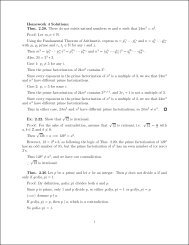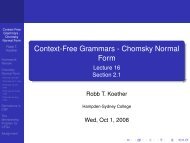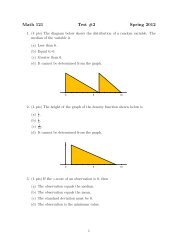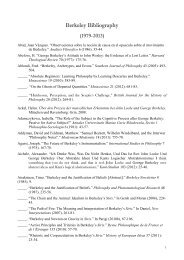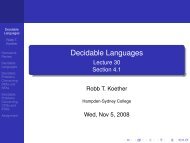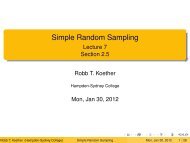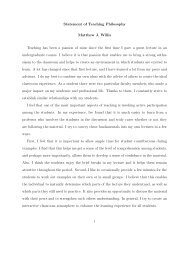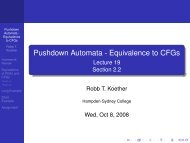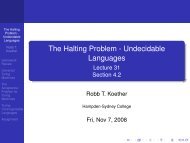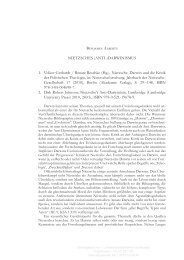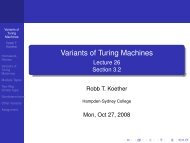Non-Context-Free Languages - The Pumping Lemma - Hampden ...
Non-Context-Free Languages - The Pumping Lemma - Hampden ...
Non-Context-Free Languages - The Pumping Lemma - Hampden ...
You also want an ePaper? Increase the reach of your titles
YUMPU automatically turns print PDFs into web optimized ePapers that Google loves.
<strong>Non</strong>-<strong>Context</strong>-<br />
<strong>Free</strong><br />
<strong>Languages</strong> -<br />
<strong>The</strong> <strong>Pumping</strong><br />
<strong>Lemma</strong><br />
Robb T.<br />
Koether<br />
Collected<br />
Problems<br />
<strong>Non</strong>-<strong>Context</strong>-<br />
<strong>Free</strong><br />
<strong>Languages</strong><br />
<strong>The</strong> <strong>Pumping</strong><br />
<strong>Lemma</strong><br />
An Example<br />
<strong>The</strong> Proof<br />
Another<br />
Example<br />
Assignment<br />
<strong>Non</strong>-<strong>Context</strong>-<strong>Free</strong> <strong>Languages</strong> - <strong>The</strong><br />
<strong>Pumping</strong> <strong>Lemma</strong><br />
Lecture 21<br />
Section 2.3<br />
Robb T. Koether<br />
<strong>Hampden</strong>-Sydney College<br />
Mon, Oct 13, 2008
Outline<br />
<strong>Non</strong>-<strong>Context</strong>-<br />
<strong>Free</strong><br />
<strong>Languages</strong> -<br />
<strong>The</strong> <strong>Pumping</strong><br />
<strong>Lemma</strong><br />
Robb T.<br />
Koether<br />
Collected<br />
Problems<br />
<strong>Non</strong>-<strong>Context</strong>-<br />
<strong>Free</strong><br />
<strong>Languages</strong><br />
<strong>The</strong> <strong>Pumping</strong><br />
<strong>Lemma</strong><br />
An Example<br />
<strong>The</strong> Proof<br />
Another<br />
Example<br />
Assignment<br />
1 Collected Problems<br />
2 <strong>Non</strong>-<strong>Context</strong>-<strong>Free</strong> <strong>Languages</strong><br />
3 <strong>The</strong> <strong>Pumping</strong> <strong>Lemma</strong><br />
4 An Example<br />
5 <strong>The</strong> Proof<br />
6 Another Example<br />
7 Assignment
Collected Problems<br />
<strong>Non</strong>-<strong>Context</strong>-<br />
<strong>Free</strong><br />
<strong>Languages</strong> -<br />
<strong>The</strong> <strong>Pumping</strong><br />
<strong>Lemma</strong><br />
Robb T.<br />
Koether<br />
Collected<br />
Problems<br />
<strong>Non</strong>-<strong>Context</strong>-<br />
<strong>Free</strong><br />
<strong>Languages</strong><br />
<strong>The</strong> <strong>Pumping</strong><br />
<strong>Lemma</strong><br />
An Example<br />
<strong>The</strong> Proof<br />
Another<br />
Example<br />
Assignment<br />
Due Wed, Oct 15, 2008<br />
Page 128: Exercises 3, 14.<br />
Page 130: Problem 23.<br />
Design a PDA whose language is<br />
{a n b m c m d n | m, n ≥ 0}.<br />
Find a simplified grammar for the language<br />
L = {w | w contains an equal number of a’s and b’s}<br />
with PDA...
Collected Problems<br />
<strong>Non</strong>-<strong>Context</strong>-<br />
<strong>Free</strong><br />
<strong>Languages</strong> -<br />
<strong>The</strong> <strong>Pumping</strong><br />
<strong>Lemma</strong><br />
Robb T.<br />
Koether<br />
Collected<br />
Problems<br />
<strong>Non</strong>-<strong>Context</strong>-<br />
<strong>Free</strong><br />
<strong>Languages</strong><br />
<strong>The</strong> <strong>Pumping</strong><br />
<strong>Lemma</strong><br />
An Example<br />
<strong>The</strong> Proof<br />
Due Wed, Oct 15, 2008<br />
a, ε → a<br />
a, b → ε<br />
b, a → ε b, ε → b<br />
a > b<br />
a, ε → $ b, ε → $<br />
b. $ → ε<br />
a. $ → ε<br />
a < b<br />
Another<br />
Example<br />
Assignment
<strong>Non</strong>-<strong>Context</strong>-<strong>Free</strong> <strong>Languages</strong><br />
<strong>Non</strong>-<strong>Context</strong>-<br />
<strong>Free</strong><br />
<strong>Languages</strong> -<br />
<strong>The</strong> <strong>Pumping</strong><br />
<strong>Lemma</strong><br />
Robb T.<br />
Koether<br />
Collected<br />
Problems<br />
<strong>Non</strong>-<strong>Context</strong>-<br />
<strong>Free</strong><br />
<strong>Languages</strong><br />
<strong>The</strong> <strong>Pumping</strong><br />
<strong>Lemma</strong><br />
An Example<br />
It turns out that not all languages are context-free.<br />
<strong>The</strong> simplest example of a non-context-free language is<br />
{a n b n c n | n ≥ 0}.<br />
To process this would require two stacks.<br />
<strong>The</strong> Proof<br />
Another<br />
Example<br />
Assignment
<strong>The</strong> <strong>Pumping</strong> <strong>Lemma</strong><br />
<strong>Non</strong>-<strong>Context</strong>-<br />
<strong>Free</strong><br />
<strong>Languages</strong> -<br />
<strong>The</strong> <strong>Pumping</strong><br />
<strong>Lemma</strong><br />
Robb T.<br />
Koether<br />
Collected<br />
Problems<br />
<strong>Non</strong>-<strong>Context</strong>-<br />
<strong>Free</strong><br />
<strong>Languages</strong><br />
<strong>The</strong> <strong>Pumping</strong><br />
<strong>Lemma</strong><br />
An Example<br />
<strong>The</strong> Proof<br />
Another<br />
Example<br />
<strong>The</strong>orem (<strong>The</strong> <strong>Pumping</strong> <strong>Lemma</strong> for <strong>Context</strong>-<strong>Free</strong><br />
Grammars)<br />
If L is a context-free language then there exists an integer p<br />
such that if any string s ∈ L has length at least p, then s may<br />
be divided into five substrings s = uvxyz such that<br />
|vy| > 0,<br />
|vxy| ≤ p,<br />
uv i xy i z ∈ L for all i ≥ 0.<br />
Assignment
<strong>The</strong> Proof<br />
<strong>Non</strong>-<strong>Context</strong>-<br />
<strong>Free</strong><br />
<strong>Languages</strong> -<br />
<strong>The</strong> <strong>Pumping</strong><br />
<strong>Lemma</strong><br />
Robb T.<br />
Koether<br />
Collected<br />
Problems<br />
<strong>Non</strong>-<strong>Context</strong>-<br />
<strong>Free</strong><br />
<strong>Languages</strong><br />
<strong>The</strong> <strong>Pumping</strong><br />
<strong>Lemma</strong><br />
<strong>The</strong> proof is somewhat similar to the proof of the<br />
<strong>Pumping</strong> <strong>Lemma</strong> for Regular <strong>Languages</strong> except that it<br />
is based on a grammar rather than a machine.<br />
But first, an example. . .<br />
An Example<br />
<strong>The</strong> Proof<br />
Another<br />
Example<br />
Assignment
An Example<br />
<strong>Non</strong>-<strong>Context</strong>-<br />
<strong>Free</strong><br />
<strong>Languages</strong> -<br />
<strong>The</strong> <strong>Pumping</strong><br />
<strong>Lemma</strong><br />
Robb T.<br />
Koether<br />
Collected<br />
Problems<br />
<strong>Non</strong>-<strong>Context</strong>-<br />
<strong>Free</strong><br />
<strong>Languages</strong><br />
<strong>The</strong> <strong>Pumping</strong><br />
<strong>Lemma</strong><br />
Example<br />
Let L = {a n b n c n | n ≥ 0}.<br />
We will use the <strong>Pumping</strong> <strong>Lemma</strong> to show that L is not<br />
context-free.<br />
An Example<br />
<strong>The</strong> Proof<br />
Another<br />
Example<br />
Assignment
An Example<br />
<strong>Non</strong>-<strong>Context</strong>-<br />
<strong>Free</strong><br />
<strong>Languages</strong> -<br />
<strong>The</strong> <strong>Pumping</strong><br />
<strong>Lemma</strong><br />
Robb T.<br />
Koether<br />
Collected<br />
Problems<br />
<strong>Non</strong>-<strong>Context</strong>-<br />
<strong>Free</strong><br />
<strong>Languages</strong><br />
<strong>The</strong> <strong>Pumping</strong><br />
<strong>Lemma</strong><br />
An Example<br />
<strong>The</strong> Proof<br />
Proof.<br />
Suppose it is.<br />
<strong>The</strong>n let p be the “pumping length” (for CFLs).<br />
Let s = a p b p c p .<br />
<strong>The</strong>n s = uvxyz such that |vy| > 0, |vxy| ≤ p, and<br />
uv i xy i z ∈ L.<br />
We will show that this is not possible.<br />
Another<br />
Example<br />
Assignment
An Example<br />
<strong>Non</strong>-<strong>Context</strong>-<br />
<strong>Free</strong><br />
<strong>Languages</strong> -<br />
<strong>The</strong> <strong>Pumping</strong><br />
<strong>Lemma</strong><br />
Robb T.<br />
Koether<br />
Collected<br />
Problems<br />
<strong>Non</strong>-<strong>Context</strong>-<br />
<strong>Free</strong><br />
<strong>Languages</strong><br />
<strong>The</strong> <strong>Pumping</strong><br />
<strong>Lemma</strong><br />
An Example<br />
<strong>The</strong> Proof<br />
Another<br />
Example<br />
Proof.<br />
vxy is the “middle part” of uvxyz and it has length at<br />
most p.<br />
<strong>The</strong>refore, it consists of<br />
Case 1: All a’s,<br />
Case 2: Some a’s followed by some b’s,<br />
Case 3: All b’s,<br />
Case 4: Some b’s followed by some c’s, or<br />
Case 5: All c’s.<br />
Assignment
An Example<br />
<strong>Non</strong>-<strong>Context</strong>-<br />
<strong>Free</strong><br />
<strong>Languages</strong> -<br />
<strong>The</strong> <strong>Pumping</strong><br />
<strong>Lemma</strong><br />
Robb T.<br />
Koether<br />
Collected<br />
Problems<br />
<strong>Non</strong>-<strong>Context</strong>-<br />
<strong>Free</strong><br />
<strong>Languages</strong><br />
<strong>The</strong> <strong>Pumping</strong><br />
<strong>Lemma</strong><br />
An Example<br />
<strong>The</strong> Proof<br />
Proof.<br />
It is enough to consider the first two cases.<br />
<strong>The</strong> other three cases are similar.<br />
Case 1: Suppose vxy consists of all a’s.<br />
<strong>The</strong>n v = a k and y = a m for some k, m, not both 0.<br />
So uv 2 xy 2 z = a p+k+m b p c p , which is not in L.<br />
This is a contradiction.<br />
Another<br />
Example<br />
Assignment
An Example<br />
<strong>Non</strong>-<strong>Context</strong>-<br />
<strong>Free</strong><br />
<strong>Languages</strong> -<br />
<strong>The</strong> <strong>Pumping</strong><br />
<strong>Lemma</strong><br />
Robb T.<br />
Koether<br />
Collected<br />
Problems<br />
<strong>Non</strong>-<strong>Context</strong>-<br />
<strong>Free</strong><br />
<strong>Languages</strong><br />
<strong>The</strong> <strong>Pumping</strong><br />
<strong>Lemma</strong><br />
Proof.<br />
Case 2: vxy consists of some a’s followed by some b’s.<br />
<strong>The</strong>re are three possibilities (Geez Louise!):<br />
v is all a’s and y is all b’s,<br />
v is all a’s and y is some a’s followed by some b’s,<br />
v is some a’s followed by some b’s and y is all b’s.<br />
An Example<br />
<strong>The</strong> Proof<br />
Another<br />
Example<br />
Assignment
An Example<br />
<strong>Non</strong>-<strong>Context</strong>-<br />
<strong>Free</strong><br />
<strong>Languages</strong> -<br />
<strong>The</strong> <strong>Pumping</strong><br />
<strong>Lemma</strong><br />
Robb T.<br />
Koether<br />
Collected<br />
Problems<br />
<strong>Non</strong>-<strong>Context</strong>-<br />
<strong>Free</strong><br />
<strong>Languages</strong><br />
<strong>The</strong> <strong>Pumping</strong><br />
<strong>Lemma</strong><br />
An Example<br />
<strong>The</strong> Proof<br />
Another<br />
Example<br />
Assignment<br />
Proof.<br />
Case 2, continued. . .<br />
It doesn’t really matter which is the case because both v<br />
and y get pumped up.<br />
Let k be the number of a’s and m be the number of b’s<br />
altogether in vy, m and k are not both 0 (but possibly<br />
m = k).<br />
So uv 2 xy 2 z will contain p + k a’s and p + m b’s, but only p<br />
c’s.<br />
So uv 2 xy 2 z /∈ L.<br />
This is a contradiction.<br />
Cases 3, 4, and 5 are similar.<br />
<strong>The</strong>refore, L is not context-free.
<strong>The</strong> Idea Behind the Proof<br />
<strong>Non</strong>-<strong>Context</strong>-<br />
<strong>Free</strong><br />
<strong>Languages</strong> -<br />
<strong>The</strong> <strong>Pumping</strong><br />
<strong>Lemma</strong><br />
Robb T.<br />
Koether<br />
Collected<br />
Problems<br />
<strong>Non</strong>-<strong>Context</strong>-<br />
<strong>Free</strong><br />
<strong>Languages</strong><br />
<strong>The</strong> <strong>Pumping</strong><br />
<strong>Lemma</strong><br />
An Example<br />
<strong>The</strong> Proof<br />
Another<br />
Example<br />
Assignment<br />
If a CFL contains a string w with a sufficiently long<br />
derivation<br />
S ∗ =⇒ w,<br />
then some variable A must appear more than once in<br />
the derivation.<br />
That is, we must have<br />
S ∗ =⇒ uAz ∗ =⇒ uvAyz ∗ =⇒ uvxyz,<br />
for some strings u, v, x, y, and z.
<strong>The</strong> Idea Behind the Proof<br />
<strong>Non</strong>-<strong>Context</strong>-<br />
<strong>Free</strong><br />
<strong>Languages</strong> -<br />
<strong>The</strong> <strong>Pumping</strong><br />
<strong>Lemma</strong><br />
Robb T.<br />
Koether<br />
Collected<br />
Problems<br />
<strong>Non</strong>-<strong>Context</strong>-<br />
<strong>Free</strong><br />
<strong>Languages</strong><br />
<strong>The</strong> <strong>Pumping</strong><br />
<strong>Lemma</strong><br />
An Example<br />
<strong>The</strong> Proof<br />
Thus, A ∗ =⇒ vAy and A ∗ =⇒ x.<br />
We may repeat the derivation<br />
A ∗ =⇒ vAy<br />
as many times as we like (including zero times),<br />
producing strings uv n xy n z, for any n ≥ 0.<br />
Another<br />
Example<br />
Assignment
<strong>The</strong> Proof<br />
<strong>Non</strong>-<strong>Context</strong>-<br />
<strong>Free</strong><br />
<strong>Languages</strong> -<br />
<strong>The</strong> <strong>Pumping</strong><br />
<strong>Lemma</strong><br />
Robb T.<br />
Koether<br />
Collected<br />
Problems<br />
<strong>Non</strong>-<strong>Context</strong>-<br />
<strong>Free</strong><br />
<strong>Languages</strong><br />
<strong>The</strong> <strong>Pumping</strong><br />
<strong>Lemma</strong><br />
An Example<br />
<strong>The</strong> Proof<br />
Another<br />
Example<br />
Proof.<br />
Let b be the largest number of symbols on the<br />
right-hand side of any grammar rule.<br />
(Assume b ≥ 2.)<br />
Let h be the height of the derivation tree of a string s.<br />
<strong>The</strong>n s can contain at most b h symbols.<br />
Equivalently, if s contains more than b h symbols, then<br />
the height of the derivation tree of s must be more h.<br />
Assignment
<strong>The</strong> Proof<br />
<strong>Non</strong>-<strong>Context</strong>-<br />
<strong>Free</strong><br />
<strong>Languages</strong> -<br />
<strong>The</strong> <strong>Pumping</strong><br />
<strong>Lemma</strong><br />
Robb T.<br />
Koether<br />
Collected<br />
Problems<br />
<strong>Non</strong>-<strong>Context</strong>-<br />
<strong>Free</strong><br />
<strong>Languages</strong><br />
<strong>The</strong> <strong>Pumping</strong><br />
<strong>Lemma</strong><br />
An Example<br />
<strong>The</strong> Proof<br />
Proof.<br />
Now |V| is the number of variables in the grammar of L.<br />
So if a string in L has a length greater than b |V|+1 , then<br />
the height of its derivation tree must be more than<br />
|V| + 1.<br />
So let p = b |V|+1 and suppose that a string s ∈ L has<br />
length at least p.<br />
Another<br />
Example<br />
Assignment
<strong>The</strong> Proof<br />
<strong>Non</strong>-<strong>Context</strong>-<br />
<strong>Free</strong><br />
<strong>Languages</strong> -<br />
<strong>The</strong> <strong>Pumping</strong><br />
<strong>Lemma</strong><br />
Robb T.<br />
Koether<br />
Collected<br />
Problems<br />
<strong>Non</strong>-<strong>Context</strong>-<br />
<strong>Free</strong><br />
<strong>Languages</strong><br />
<strong>The</strong> <strong>Pumping</strong><br />
<strong>Lemma</strong><br />
An Example<br />
Proof.<br />
Consider the longest path through the derivation tree of<br />
s.<br />
It has length at least |V| + 1.<br />
That path has |V| + 2 nodes on it, counting the root<br />
node S and the leaf node, which is a terminal.<br />
<strong>The</strong> Proof<br />
Another<br />
Example<br />
Assignment
<strong>The</strong> Proof<br />
<strong>Non</strong>-<strong>Context</strong>-<br />
<strong>Free</strong><br />
<strong>Languages</strong> -<br />
<strong>The</strong> <strong>Pumping</strong><br />
<strong>Lemma</strong><br />
Robb T.<br />
Koether<br />
Collected<br />
Problems<br />
<strong>Non</strong>-<strong>Context</strong>-<br />
<strong>Free</strong><br />
<strong>Languages</strong><br />
<strong>The</strong> <strong>Pumping</strong><br />
<strong>Lemma</strong><br />
An Example<br />
<strong>The</strong> Proof<br />
Proof.<br />
Thus, |V| + 1 of the nodes are variables.<br />
So one of them must be repeated.<br />
As we follow the longest path back from leaf to root, let<br />
A be the first variable that repeats.<br />
Now consider these two occurrences of A along the<br />
longest path.<br />
Another<br />
Example<br />
Assignment
<strong>The</strong> Proof<br />
<strong>Non</strong>-<strong>Context</strong>-<br />
<strong>Free</strong><br />
<strong>Languages</strong> -<br />
<strong>The</strong> <strong>Pumping</strong><br />
<strong>Lemma</strong><br />
Robb T.<br />
Koether<br />
S<br />
Collected<br />
Problems<br />
<strong>Non</strong>-<strong>Context</strong>-<br />
<strong>Free</strong><br />
<strong>Languages</strong><br />
u<br />
A<br />
v<br />
<strong>The</strong> <strong>Pumping</strong><br />
<strong>Lemma</strong><br />
An Example<br />
y<br />
A<br />
z<br />
<strong>The</strong> Proof<br />
Another<br />
Example<br />
Assignment<br />
x
<strong>The</strong> Proof<br />
<strong>Non</strong>-<strong>Context</strong>-<br />
<strong>Free</strong><br />
<strong>Languages</strong> -<br />
<strong>The</strong> <strong>Pumping</strong><br />
<strong>Lemma</strong><br />
Robb T.<br />
Koether<br />
Collected<br />
Problems<br />
<strong>Non</strong>-<strong>Context</strong>-<br />
<strong>Free</strong><br />
<strong>Languages</strong><br />
<strong>The</strong> <strong>Pumping</strong><br />
<strong>Lemma</strong><br />
An Example<br />
Proof.<br />
<strong>The</strong> “middle part” of this tree, the part that produces<br />
A =⇒ ∗ vAy,<br />
may be repeated as many times as desired.<br />
<strong>The</strong> Proof<br />
Another<br />
Example<br />
Assignment
<strong>The</strong> Proof<br />
<strong>Non</strong>-<strong>Context</strong>-<br />
<strong>Free</strong><br />
<strong>Languages</strong> -<br />
<strong>The</strong> <strong>Pumping</strong><br />
<strong>Lemma</strong><br />
S<br />
Robb T.<br />
Koether<br />
Collected<br />
Problems<br />
u<br />
A<br />
v<br />
<strong>Non</strong>-<strong>Context</strong>-<br />
<strong>Free</strong><br />
<strong>Languages</strong><br />
y<br />
A<br />
z<br />
<strong>The</strong> <strong>Pumping</strong><br />
<strong>Lemma</strong><br />
An Example<br />
<strong>The</strong> Proof<br />
x<br />
Another<br />
Example<br />
Assignment
<strong>The</strong> Proof<br />
<strong>Non</strong>-<strong>Context</strong>-<br />
<strong>Free</strong><br />
<strong>Languages</strong> -<br />
<strong>The</strong> <strong>Pumping</strong><br />
<strong>Lemma</strong><br />
S<br />
Robb T.<br />
Koether<br />
Collected<br />
Problems<br />
u<br />
A<br />
v<br />
<strong>Non</strong>-<strong>Context</strong>-<br />
<strong>Free</strong><br />
<strong>Languages</strong><br />
y<br />
A<br />
z<br />
<strong>The</strong> <strong>Pumping</strong><br />
<strong>Lemma</strong><br />
An Example<br />
<strong>The</strong> Proof<br />
y<br />
A<br />
z<br />
Another<br />
Example<br />
Assignment<br />
x
<strong>The</strong> Proof<br />
<strong>Non</strong>-<strong>Context</strong>-<br />
<strong>Free</strong><br />
<strong>Languages</strong> -<br />
<strong>The</strong> <strong>Pumping</strong><br />
<strong>Lemma</strong><br />
Robb T.<br />
Koether<br />
Collected<br />
Problems<br />
<strong>Non</strong>-<strong>Context</strong>-<br />
<strong>Free</strong><br />
<strong>Languages</strong><br />
<strong>The</strong> <strong>Pumping</strong><br />
<strong>Lemma</strong><br />
An Example<br />
<strong>The</strong> Proof<br />
Another<br />
Example<br />
Assignment<br />
Proof.<br />
<strong>The</strong>refore, the strings uv 2 xy 2 z, uv 3 xy 3 z, etc. can also be<br />
derived.<br />
So can the string uxz.<br />
Furthermore, we may assume that this was the<br />
shortest derivation of s.<br />
It follows that v and y cannot both be empty strings.<br />
If they were, then the middle part of the derivation<br />
would be<br />
A ∗ =⇒ A,<br />
which could be eliminated.<br />
Thus, |vy| > 0.
<strong>The</strong> Proof<br />
<strong>Non</strong>-<strong>Context</strong>-<br />
<strong>Free</strong><br />
<strong>Languages</strong> -<br />
<strong>The</strong> <strong>Pumping</strong><br />
<strong>Lemma</strong><br />
Robb T.<br />
Koether<br />
Collected<br />
Problems<br />
<strong>Non</strong>-<strong>Context</strong>-<br />
<strong>Free</strong><br />
<strong>Languages</strong><br />
<strong>The</strong> <strong>Pumping</strong><br />
<strong>Lemma</strong><br />
Proof, conclusion.<br />
Finally, we must show that |vxy| ≤ p.<br />
<strong>The</strong> subtree rooted at the second-to-last A has height<br />
at most |V| + 1.<br />
So the string vxy has at most b |V|+1 = p symbols.<br />
An Example<br />
<strong>The</strong> Proof<br />
Another<br />
Example<br />
Assignment
An Example<br />
<strong>Non</strong>-<strong>Context</strong>-<br />
<strong>Free</strong><br />
<strong>Languages</strong> -<br />
<strong>The</strong> <strong>Pumping</strong><br />
<strong>Lemma</strong><br />
Robb T.<br />
Koether<br />
Collected<br />
Problems<br />
<strong>Non</strong>-<strong>Context</strong>-<br />
<strong>Free</strong><br />
<strong>Languages</strong><br />
<strong>The</strong> <strong>Pumping</strong><br />
<strong>Lemma</strong><br />
An Example<br />
<strong>The</strong> Proof<br />
Another<br />
Example<br />
Example<br />
Let Σ = {a, b}.<br />
Show that the language<br />
{ww | w ∈ Σ ∗ }<br />
is not context-free.<br />
Use s = a p b p a p b p .<br />
Assignment
Assignment<br />
<strong>Non</strong>-<strong>Context</strong>-<br />
<strong>Free</strong><br />
<strong>Languages</strong> -<br />
<strong>The</strong> <strong>Pumping</strong><br />
<strong>Lemma</strong><br />
Robb T.<br />
Koether<br />
Collected<br />
Problems<br />
<strong>Non</strong>-<strong>Context</strong>-<br />
<strong>Free</strong><br />
<strong>Languages</strong><br />
<strong>The</strong> <strong>Pumping</strong><br />
<strong>Lemma</strong><br />
Homework<br />
Read Section 2.3, pages 123 - 127.<br />
Exercise 13, page 129.<br />
Problems 30, 31, page 131.<br />
An Example<br />
<strong>The</strong> Proof<br />
Another<br />
Example<br />
Assignment



